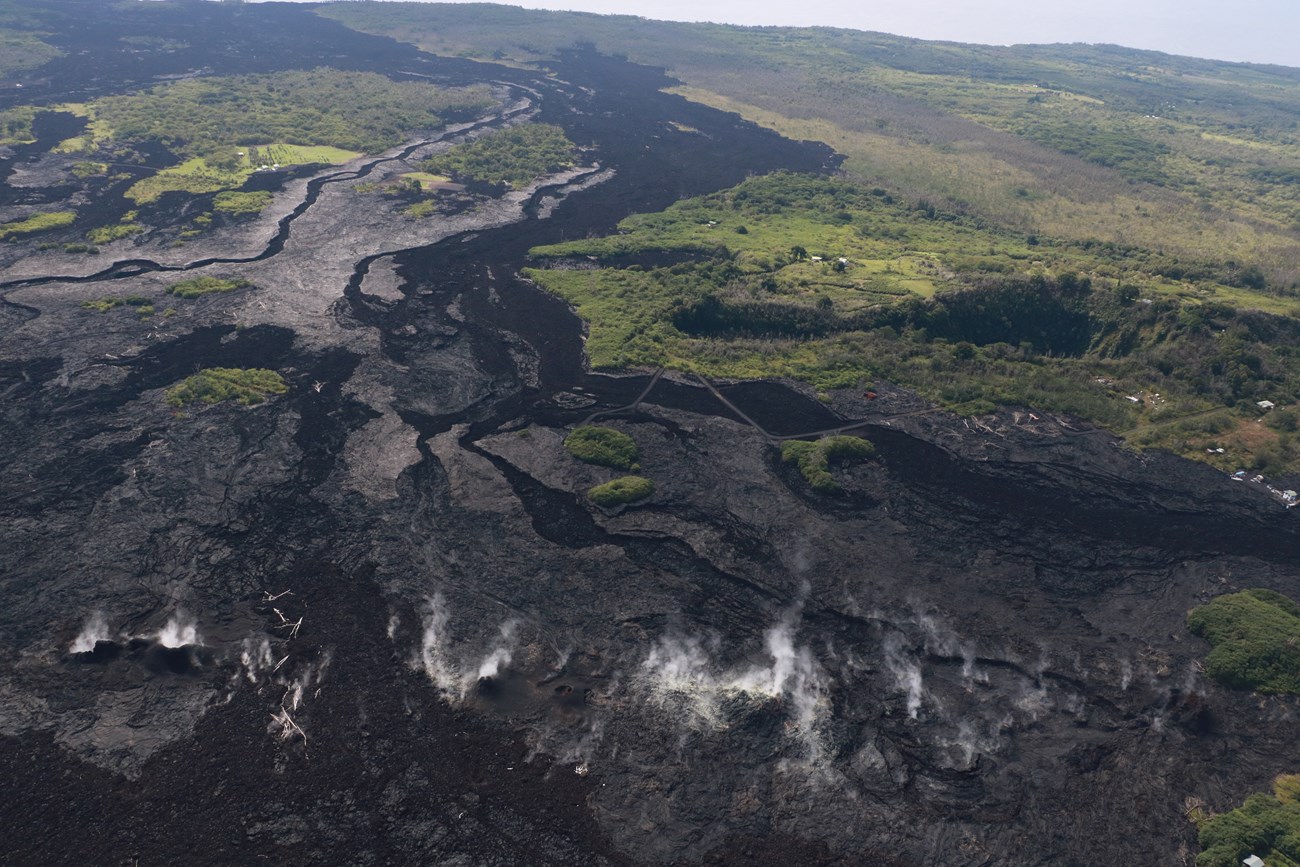
USGS photo.
Introduction
Volcanoes are built, modified, and rebuilt through eruptions. Most volcanoes are mountains, or at least low hills, that are made up of deposits formed in those eruptions. Depending on whether an eruption is effusive or explosive, they may produce lava flows or pyroclastic deposits respectively. Other types of volcanic deposits include volcanic domes, and those left by lahars and landslides.
Lava Flows
Lava flows are outpourings of molten rock from a vent onto Earth's surface during an effusive volcanic eruption. Fluid basaltic lava flows may travel great distances from their vent. But more viscous (less fluid) types of lava are not able to travel as far, and form shorter and thicker lava flows. The surfaces of young lava flows are usually very irregular and rough, and covered with clinkers, blocks, loose boulders, mounds, and fractures.
Learn More
Lava Domes
Volcanic domes are made up of silicic lavas with extremely high viscosity. Instead of spreading laterally to make a lava flow, lava mounds up above a vent. Lava domes typically have rough brecciated surfaces, and sometimes they have glassy rinds due to rapid quenching of the hot lava after eruption.
Learn More
Pyroclasts and Pyroclastic Rocks
Pyroclasts are the fragmentary material formed during explosive eruptions when magma, crystals, and preexisting rocks are shattered. Volcanic gases that are rapidly exsolving and expanding as magma approaches the surface and at the vent provide the main forces that create volcanic ash, lapilli, blocks, and volcanic bombs.
A great range of pyroclastic deposits exists. Basaltic cinders can pile up around vents to form cinder cone volcanoes. Highly explosive eruptions of silicic magmas can create great quantities of volcanic ash and pumice that can form ash-fall or ash-flow deposits. Ash-fall deposits from extremely large eruptions may be found in areas as large as thousands of square miles (km).
Learn More
Lahar Deposits
Lahars are volcanic mudflows that occur predominantly on composite volcanoes. Composite volcanoes are steep and contain a lot of rock that has been weakened by hydrothermal alteration. Lahars may occur during eruptions or at other times. Melting snow and ice may mix with pyroclastic debris during an eruption or heavy precipitation or snowmelt may induce lahar events. Lahars flow like wet concrete and their deposits are a jumble of volcanic ash and rock fragments.
Learn More
Volcano Types and Their Characteristic Volcanic Deposits
Each type of volcano is made up of its own characteristic types of volcanic deposits.
-
Cinder cones are made up almost exclusively of ash and cinders. Cinders are small nut- to fist-sized pieces of scoria erupted during Strombolian eruptions. Lava flows may be erupted from vents located near their base.
-
Shield volcanoes mostly consist of stacks of fluid lava flows emitted from vents located at the summit or on rift zones aligned along its flanks.
-
Composite volcanoes are made of both lava flows and pyroclastic deposits, as well as lahar deposits generated by volcanic mudflows. Lahars may be initiated during eruptions or at other times due to heavy rain or snowmelt. Lava domes may also form within their summit craters.
-
Volcanic domes consist of one or more lava domes erupted during effusive eruptions. Domes form when silicic lavas are too viscous to flow laterally, and instead pile up near the vent. Volcanic domes are both a type of volcano in their own right, and a type of deposit that is a part of composite volcanoes.
-
Maars and tuff rings consist of low rings of ash and pyroclastic deposits formed during highly explosive phreatomagmatic (hydrovolcanic) eruptions.
-
Fissure volcanoes erupt fluid lava flows that may travel great distances from the eruptive fissures. There may be small accumulations of spatter (welded cinders) near the vent from lava fountaining during eruptions.
-
Monogenetic volcanic fields may contain cinder cones, maars, tuff rings, and fissure volcanoes. Cinder cones, maars, and tuff rings are made of accumulations of pyroclastic deposits. Fissure volcanoes erupt lava flows.
-
Calderas are collapse features that form during eruptions that produce large-volumes of volcanic deposits.
-
Nonexplosive calderas form on shield volcanoes where lava flows are erupted. They may be filled by lava lakes.
-
Explosive calderas may form at the summit of composite volcanoes. They may also form in other areas that have previously experienced volcanism but are on a single preexisting volcanic edifice. Caldera-forming eruptions produce massive eruption columns that extend into the stratosphere. Voluminous ash-fall and ash-flow deposits are produced during the formation of explosive calderas.
-
Learn More
Last updated: October 3, 2022
